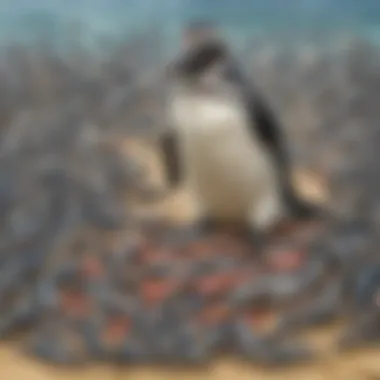Unveiling the Gastronomic Delights of the Galapagos Penguin: A Dietary Exploration


Interactive Learning Games
Galapagos penguins, despite their small size, have a diverse diet that plays a crucial role in their survival in the unique ecosystem of the Galapagos Islands. These fascinating creatures primarily feed on marine species like small fish, squid, and crustaceans. Their feeding behavior is a sight to behold, as they gracefully dive into the crystal-clear waters surrounding the islands in search of their next meal. The Galapagos penguin's preferred food sources are abundant in the rich waters of the region, allowing them to thrive in their natural habitat.
As we delve deeper into the dietary habits of the Galapagos penguin, it becomes evident that their adaptations for survival are closely intertwined with their choice of food. By consuming a variety of marine organisms, these penguins have developed physiological and behavioral characteristics that aid in their efficient hunting and digestion. Through a detailed examination of their diet, we can gain a better understanding of the ecological significance of the Galapagos penguin and the delicate balance it maintains within its environment.
Educational Topics
The Galapagos penguin's dietary preferences offer a unique opportunity for interdisciplinary learning, encompassing subjects such as marine biology, conservation, and ecosystem dynamics. Understanding what sustains these enigmatic creatures not only broadens our knowledge of their habitat but also underscores the interconnectedness of marine life in delicate ecosystems. By exploring the educational avenues that stem from studying the diet of the Galapagos penguin, we unlock a wealth of knowledge that transcends traditional academic boundaries.
Tips and Tricks
For parents, educators, and curious minds alike, uncovering the dietary secrets of the Galapagos penguin presents a valuable teaching moment. Practical tips for immersing oneself in the world of marine wildlife, understanding food chains, and exploring the importance of conservation efforts can amplify the educational experience. By weaving the dietary habits of these penguins into educational activities, we nurture a sense of curiosity, responsibility, and environmental stewardship among learners of all ages.
Introduction
The dietary habits of the Galapagos penguin are a fascinating subject that sheds light on this unique species' ecological niche. Understanding what the Galapagos penguin consumes is crucial to grasp its role in the delicate balance of the ecosystem. As an endemic species to the Galapagos Islands, the penguin's diet not only defines its survival strategies but also reflects the environmental conditions of its habitat. By exploring what the Galapagos penguin eats, we can appreciate the intricate web of interactions in these remote islands' marine ecosystem. This article delves into the depths of the Galapagos penguin's feeding habits, offering valuable insights into its lifestyle and conservation needs.
Overview of the Galapagos Penguin
The Galapagos penguin, scientifically known as Spheniscus mendiculus, is a species uniquely adapted to thrive in the harsh conditions of the Galapagos archipelago. Being the only penguin species to reside north of the equator, these birds have evolved distinct feeding behaviors to suit their marine environment. With a small population size and limited foraging range, the Galapagos penguin primarily relies on a diet composed of fish and squid. Unlike their cold-weather counterparts, these penguins face challenges related to warm water temperatures, affecting the availability of their prey. Despite these challenges, the Galapagos penguin has adapted mechanisms to make the most of their food sources, highlighting their resilience in the face of adversity.


Feeding Behavior
In this article on the dietary habits of the Galapagos penguin, one crucial aspect to delve into is their feeding behavior. Understanding how these penguins acquire and consume food is fundamental to grasping their ecological role within their habitat. The feeding behavior of the Galapagos penguin encompasses various techniques and patterns that showcase their adaptability and efficiency in securing sustenance.
Hunting Techniques
Diving for Prey
A significant hunting technique employed by Galapagos penguins is diving for prey. This method involves the penguins plunging into the waters in search of fish and squid, their primary food sources. Diving for prey allows these penguins to access nutrient-rich marine life vital for their survival. The unique characteristic of this hunting technique lies in the penguins' remarkable underwater agility and speed, enabling them to catch agile prey with precision. Despite its advantages, diving for prey can be physically demanding for the penguins, requiring immense energy expenditure to navigate the depths and capture their quarry.
Schooling Behavior
Another noteworthy hunting strategy exhibited by Galapagos penguins is schooling behavior. This behavior involves the penguins congregating in groups to corral and trap fish effectively. By working together, the penguins increase their hunting success rate, capitalizing on the collective intelligence and coordination of the group. Schooling behavior is a collaborative approach that showcases the social nature of these birds, emphasizing cooperation and synchronization in securing a bountiful meal. While advantageous in enhancing hunting efficiency, schooling behavior can also attract competition from other marine predators vying for the same food sources.
Feeding Frequency
The feeding frequency of Galapagos penguins is a vital aspect to explore in understanding their nutritional requirements and foraging patterns. These penguins typically feed multiple times throughout the day, with varying intervals between meals depending on resource availability and energy demands. The regular feeding regimen of Galapagos penguins underscores their need to sustain their metabolic activities, maintain body condition, and nurture their offspring. Understanding the feeding frequency of these penguins provides insight into their adaptive strategies for survival in the dynamic marine environment, where food availability fluctuates seasonally and due to environmental factors.
Preferred Food Sources
When it comes to understanding the dietary habits of the Galapagos penguin, focusing on their preferred food sources is crucial. These sources play a vital role in the penguin's survival and overall ecosystem. The Galapagos penguin predominantly feeds on fish and squid, with specific preferences towards sardines, anchovies, and mackerel, which provide essential nutrients for their sustenance.


Fish Diet
The Galapagos penguin's fish diet is a cornerstone of their nutritional intake. Sardines, a preferred choice, offer a rich source of protein and omega-3 fatty acids. Their small size and abundance in the penguin's habitat make them an efficient and energy-rich food source. Anchovies, another staple in the penguin's diet, are known for their high protein content and contribution to the penguin's energy reserves. Mackerel, with its distinct flavor and nutrient profile, provides a significant source of vitamins and minerals for the Galapagos penguin.
Sardines
Sardines are an integral part of the Galapagos penguin's diet, offering a compact source of essential nutrients. Their high protein content supports the penguin's muscle growth and repair, while omega-3 fatty acids aid in maintaining the bird's cardiovascular health. The small size of sardines allows the penguins to consume them efficiently, extracting maximum nutritional benefits from these fish.
Anchovies
Anchovies are highly prized by the Galapagos penguin for their protein-rich flesh and small size, making them easy to consume. The abundance of anchovies in the penguin's habitat ensures a consistent food source for their sustenance. Additionally, the oils present in anchovies contribute to the penguin's overall energy reserves, helping them thrive in their challenging marine environment.
Mackerel
Mackerel stands out as a favored food choice for the Galapagos penguin due to its robust flavor profile and dense nutritional content. Rich in omega-3 fatty acids, mackerel supports the penguin's cognitive function and aids in maintaining healthy plumage. The penguins' inclination towards mackerel showcases their selective feeding behavior, opting for a diverse diet to meet their nutritional requirements.
Squid Consumption
Apart from fish, the Galapagos penguin's diet includes squid, adding variety and essential nutrients to their food intake. Squid consumption provides a valuable source of vitamins, minerals, and additional protein to supplement the penguins' diet. The Galapagos penguin's ability to diversify its food sources by including squid demonstrates their adaptability and strategic approach to securing adequate nutrition in their marine habitat.
Adaptations for Survival


The survival strategies of the Galapagos penguin are vital for its existence in its natural habitat. One crucial aspect is its heat exchange mechanisms, allowing the penguin to regulate its body temperature effectively. These mechanisms are essential to prevent overheating or hypothermia, ensuring the penguin's internal environment remains stable despite fluctuating external conditions. Additionally, metabolic strategies play a significant role in the penguin's survival. By efficiently managing energy expenditure, the penguin can thrive in its environment where food sources may be inconsistent.
Heat Exchange Mechanisms
The Galapagos penguin has evolved efficient heat exchange mechanisms to adapt to its warm surroundings. These mechanisms help the penguin dissipate excess heat when swimming in the equatorial waters. By utilizing specialized blood vessels near the skin's surface, the penguin can release heat easily, maintaining a suitable body temperature. This adaptation is crucial for the penguin's survival as it prevents heat stress, allowing them to remain active even in warmer climates.
Metabolic Strategies
In terms of metabolic strategies, the Galapagos penguin stands out for its reduced energy expenditure approach. By conserving energy during periods of limited food availability, the penguin can endure extended periods without feeding. Reduced energy expenditure allows the penguin to maintain basic physiological functions while waiting for suitable prey opportunities. This metabolic strategy showcases the penguin's ability to adapt to challenging environmental conditions, emphasizing its resilience and survival capabilities.
Challenges and Conservation
In the realm of the Galapagos penguin's biodiversity, the aspect of challenges and conservation holds paramount significance. These penguins face a myriad of obstacles in their natural habitat that necessitate robust conservation efforts to ensure their survival. The delicate balance of their ecosystem is threatened by various factors, including climate change, human encroachment, and resource depletion. Understanding the challenges these penguins encounter allows us to appreciate the critical need for conservation initiatives to protect their species and preserve the biodiversity of the Galapagos Islands.
Impact of Climate Change
The impact of climate change on the Galapagos penguin population is profound and multifaceted. Rising sea temperatures disrupt the availability of prey, leading to food scarcity and challenging the penguins' hunting patterns. Additionally, changes in ocean currents and weather patterns influence the distribution of marine resources vital to the penguins' survival. The shifting climate conditions pose a significant threat to the Galapagos penguins, highlighting the urgent need for conservation measures to mitigate the detrimental effects of global warming on this vulnerable species.
Conservation Efforts
Protected Marine Areas
Protected Marine Areas play a pivotal role in safeguarding the Galapagos penguin and its marine environment. These designated zones provide a safe haven for penguins to feed, breed, and thrive without the threat of human interference. By establishing Protected Marine Areas, conservationists can monitor and regulate human activities to prevent overfishing, pollution, and habitat destruction. The implementation of these protected zones ensures the preservation of essential ecosystems and fosters the long-term sustainability of the Galapagos penguin population.
Fishery Regulations
Fishery Regulations are instrumental in promoting the conservation of marine resources that are crucial to the Galapagos penguins' diet. By implementing strict regulations on fishing activities in penguin habitats, authorities can prevent overexploitation of fish stocks and maintain a healthy balance in the marine ecosystem. These regulations help mitigate the impact of human activities on penguin habitats, ensuring sustainable resource management and protecting the intricate food web that sustains the Galapagos penguins. Effective enforcement of fishery regulations is essential for the continued well-being of the Galapagos penguin population and the preservation of their natural habitat.















